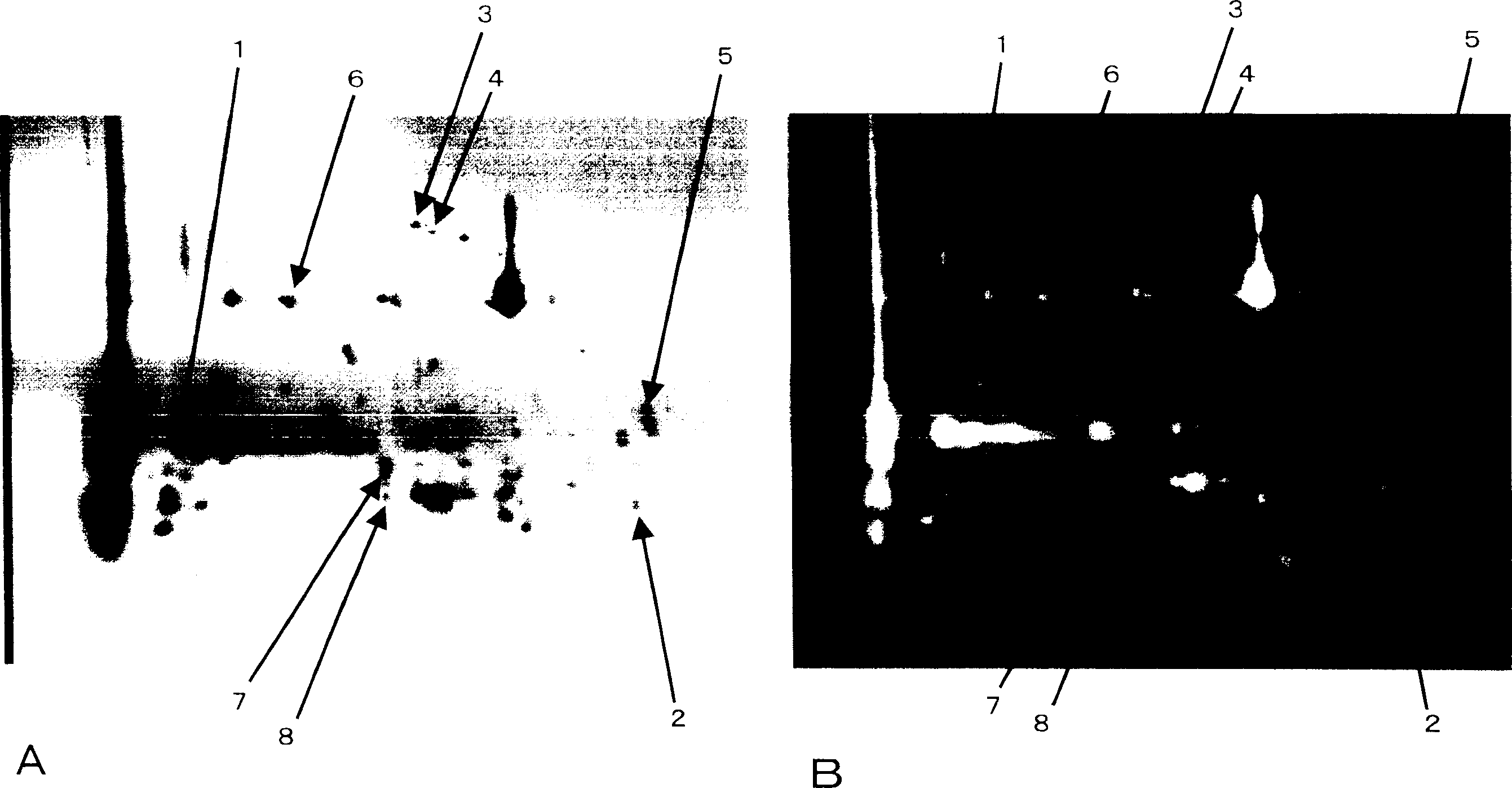Method of detecting allergen protein
A protein and allergen technology, applied in the field of protein detection, can solve the problem that there is no known method for detecting allergen protein with high sensitivity, etc.
- Summary
- Abstract
- Description
- Claims
- Application Information
AI Technical Summary
Problems solved by technology
Method used
Image
Examples
Embodiment 1
[0106] Example 1: Detection of proteins with disulfide bonds in rice extracts
[0107] Grind 20 grams of rice seeds using a mortar. The powder was placed in 400 ml of 1M sodium chloride solution and subsequently agitated for 1 hour, whereby the protein was extracted from the seeds in buffer. After the solution was centrifuged at 14,000 g for 5 minutes to precipitate insoluble components, the supernatant was collected. The supernatant was desalted by dialysis and subsequently freeze-dried. 1 / 80 amount of freeze-dried product (equivalent to 0.25 g of rice seeds) was dissolved in buffer for isoelectric focusing (8M urea, 0.5% CHAPS and 0.1% Bio-Lytes). Iodoacetamide was added to the solution as a SH group protecting agent (final concentration 5 mM), and then the solution was incubated at room temperature for 1 hour. Next, dithiothreitol was added as a reducing agent to the solution (final concentration 5 mM), and then the solution was incubated at room temperature for 1 hour...
Embodiment 2
[0115] Example 2: Analysis of allergen proteins contained in rice extracts
[0116] Will figure 2 Spots 1-6 in B where fluorescent signals were detected were excised from the gel and subsequently digested in-gel with trypsin, thereby fragmenting the proteins in the spots. After HPLC separation of the fragmented proteins, the internal amino acid sequence was determined by the Edman method. The internal amino acid sequence of the protein in each spot thus determined is shown in Table 1. "C" in the internal amino acid sequence shown in Table 1 mRRr " denotes a cysteine residue with a SH group labeled with monobromobimane. Next, each internal amino acid sequence was subjected to homology as a query sequence in amino acid sequence databases (GenBank and PIR) using the FASTA program and the BLAST program Search. The search results showed that the internal amino acid sequence of the protein from each spot was identical or highly homologous to a partial amino acid sequence of ...
Embodiment 3
[0120] Example 3: Detection of proteins with disulfide bonds in pollen extracts
[0121] Ragweed (Ambrosia trifida) pollen was ground with a mortar and pestle in 100 mM Tris-HCl buffer (pH 8.0) containing 1 mM ASF and 1 mM EDTA, and the product was then centrifuged at 14,000 g for 30 minutes. After centrifugation, the supernatant was collected, filtered through an Ultrafree-Cl centrifugal filter (Millipore), and then desalted through a Microcon YM-10 centrifugal filter. The desalted residue was dissolved in buffer for isoelectric focusing (8M urea, 0.5% CHAPS and 0.1% Bio-Lytes). Iodoacetamide was added to the solution as a SH group protecting agent (final concentration 5 mM), and the solution was incubated at room temperature for 1 hour. In addition, dithiothreitol was added as a reducing agent (final concentration 5 mM) and mixed with the solution, and then the solution was incubated at room temperature for 1 hour. In addition, monobromobimane was added as a SH-based label...
PUM
 Login to View More
Login to View More Abstract
Description
Claims
Application Information
 Login to View More
Login to View More - R&D
- Intellectual Property
- Life Sciences
- Materials
- Tech Scout
- Unparalleled Data Quality
- Higher Quality Content
- 60% Fewer Hallucinations
Browse by: Latest US Patents, China's latest patents, Technical Efficacy Thesaurus, Application Domain, Technology Topic, Popular Technical Reports.
© 2025 PatSnap. All rights reserved.Legal|Privacy policy|Modern Slavery Act Transparency Statement|Sitemap|About US| Contact US: help@patsnap.com



